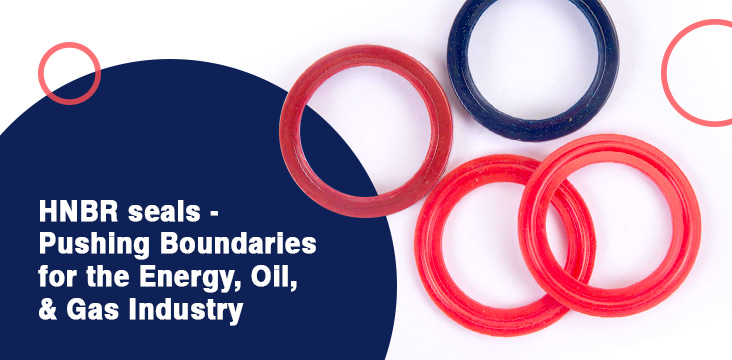HNBR seals – Pushing Boundaries for the Energy, Oil, & Gas Industry
When it comes to aggressive EOG environments that require extreme reliability, longevity, and durability, one elastomer comes to mind: Hydrogenated Nitrile Butadiene Rubber (HNBR). HNBR is renowned for its durability and retention of properties after overtime exposure to external elements like heat, oil, and chemicals that tend to weaken the durability of rubber seals.
Properties of HNBR
Hydrogenated Nitrile Butadiene Rubber (HNBR), is a variant of nitrile rubber (NBR) that has been hydrogenated to give it enhanced mechanical characteristics and, help in increasing resistance to wear and tear. The properties of hydrogenated nitrile rubber (HNBR) depend upon the acrylonitrile content (ACN) and the degree of hydrogenation of the butadiene copolymer. The fluid and chemical resistance improves as the ACN content is increased. The preceding improvements to the material properties over that of nitrile rubber (NBR) include greater thermal stability (up to 149°C/300°F, with short periods at higher temperatures), broader chemical resistance, and greater tensile strength.
Benefits of HNBR over the standard Nitrile and Fluorocarbons
1. HNBR Seals have enhanced resistance to environments that are prone to ozone and weathering, industrial lubricants, amine-based corrosion inhibitors, sour gases (H2S), and hot water/steam (150°C).
2. Maximum operating temperature +56°F (180ºC) in oil +320°F (160ºC) in air.
3. Minimum operating temperature -25ºF (-26°C) special grades –50°F (-45°C)
4. Minimum operations are much more competitive compared to existing technologies and lead to cost reducing, technical parameters improving, also strength increasing, and the better and more qualitative product.
5. Excellent aliphatic (not aromatic) hydrocarbon resistance.
6. Fit for use in methanol and sour environments, (up to 5% Hydrogen Sulfide)
Application Advantages of HNBR Seals in the Energy, Oil, & Gas Industry
HNBR seals should be considered over standard Nitriles and Fluorocarbon seals in selected applications for the following advantages:
Improved High-temperature Resistance
HNBR seals have excellent oil and fuel resistance along with superior mechanical properties and can sustain higher operating temperatures; up to 356ºF when immersed in oil. Based on the compound formulation, standard nitriles can endure a temperature ranging between 200° and 300°F. Fluorocarbons in hot water/steam tend to dissolve its mechanical properties.
Resistance to Sour Crude
Oil and gas that contains hydrogen sulfide (H2S) can cause a substantial decrease in tensile, elongation and hardness properties in standard nitrile
and fluorocarbon seals. Tests conducted have proved that HNBR seals promise stronger resistance over standard nitriles and fluorocarbon when directly in contact with heat, aggressive fluids, and corrosive chemicals.
Explosive Decompression Resistance
The compression-set resistance of HSN at high temperatures (such as 302°F) is much better than standard nitriles. Fluorocarbons show signs of compression at temperatures as low as 0°F.
Resistance to Corrosion Inhibitors
Corrosion inhibitors with standard nitriles and fluorocarbons create increased elongation, loss of elasticity and rigidity. On the other hand, HNBR seals have a higher resistance to a variety of common corrosion inhibitors.
Resistance to Explosive Decompression
Explosive decompression occurs when gas at high pressure permeates into the elastomer. Nitriles and fluorocarbons have shown lesser resistance to high-pressure CO2, as compared to HNBR.
Cost-Effective Bridge Between Nitrile Rubber (NBRs) and (per) Fluoroelastomers (FMKs)
HNBR elastomers offer optimum performance at a cost between nitrile rubber (NBRs) and (per) fluoroelastomers (FMKs). HNBR seals bridge the gap between the two elastomers in many areas of application where resistance to heat and aggressive media are required simultaneously.
HNBR seals boast of invaluable properties like high durability, tensile strength, and outstanding abrasion resistance that push the performance boundaries of elastomers in the aggressive EOG environment, therefore, giving impetus to the keep up with the continuous innovation in the Energy, Oil, & Gas Industry.








